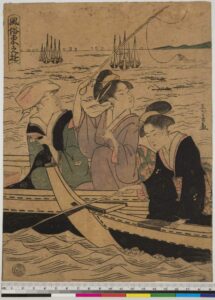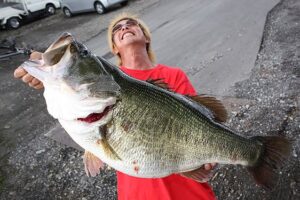Japanese Paintings on Fishing
Japan is surrounded by the sea and its moderate climate makes a lot of freshwater environments. People living here get familiar with fish and water, naturally. These things have made fishing very popular for a long time.
In this article, we briefly see the Ukiyo-e, wood prints, and paintings related to fishing in Japan. I picked up several works from which we could see what fishing meant at that time.
The first one is telling the feeling of a fisherman, after getting a nice fish. It is printed in the Meiji era, which is from 1868 to 1912. The artist is not known.
It is simple and probably it gives you the impression that it is not really sophisticated. However, the way to express the feeling is done in a Japanese way. From Japanese culture, this indirect or implication can be considered to be an art.
The tail of the fish in the basket. Slight pink colored fish. Smiling fisherman. Tangled fishing lines. Visible Mt. Fuji.
The writing on its left is a Haiku poet, saying; In this morning of spring, I can see the sky, bright and beautiful.
For your reference, it is うつくしき 空の光りや 今朝のはる
In all of these visible things, there is no mention of fishing nor the catch. However, you can see the fish is Red seabream (Pagus major,) which is the most favored fish in Japan representing prosperity and happiness. The size of its tail implies that it is a very good one. The tangled rigs with a fishing rod can let us imagine he had just caught the fish. Though it may not be long before he has caught it, he is about to move his boat. He wants to show his fish to someone back on the shore, probably. Amid his happiness, he can feel the bright sunlight. His happiness is well praised even by Mt. Fuji, which is also the symbol of prosperity in Japan.
The next one is Ukiyo-e from the Edo period. It was made by an artist called Hirokage Utagawa, in 1859.
One moment is dynamically represented in this artwork. The main fisherman, with a big hat, is setting a hook with a big action. From an angler’s perspective, it is obviously an over action in such a fine float rig. Of course the target fish should not be big in his mind, because his creel is the size of a big lunch box. At the same time, we can understand that it is likely to raise the rod like that on the movement of the float, very very well. This makes me smile. And what brings me an even bigger smile is that the angler seems to be excited from its back, for his feeling of load on his rod.
It is strange that the hook is on the bundled hair of a boy. If you target a fish with a float, the hook will not be gone there. The possible interpretation is that the hook was flown down near to the boy, and the angler’s excessive action makes the hook fly from the water. This adds another plot in this artwork that this main fisherman is with very poor skills of fishing, in my view.
The title of this print is “Fisherman in Ochano-mizu”, from the print series showing the sightseeing spots in the area around Edo. One interesting fact is that the place in the art is in the middle of downtown Tokyo. I assume the place near the below photo is the one printed in this artwork.
The below comical drawing is made in the early 1900, probably before the second World War. The artist is Ougai Tsuchiya.
Born in the Shonai region, north west of Honshu Island, where fishing had been treated as a training method for Samurai in the earlier time, this artist must have been a big fan of fishing. (Samurai or Bushido and fishing is explained in this blog.)
In this comical scene of Iso (rocky shore) fishing, one man was losing balance and tried to save himself, grasping another man’s sleeve. In the writing above, this man’s complaint is shown. “Let it go! If you pull like that, I will be falling off, too. What a man you are! Are you bringing me into the sea together? Hand off of me! I do not want to suicide with you!”
Now, let us turn our eyes to some of the modern artworks.
As I described in this article, there was a bass fishing boom in the 1990’s. Then a lot of people were hooked by this new style of game fishing. For some of these people, one of expressions of their passion was arts. Below is one example.
It is made by an artist called, Koji Yaoita. What he draws is mainly bass, Largemouth bass or Smallmouth bass. One of the notable things is the details. The above image reflects his love of lure fishing.
What reminds me of the fine graphics is this oil painting of Cherry trout, by Nobeyuki Matsui.
Not only representing the awe for the fish, but the love of fishing including the cherished tackles are shown in this artwork. This is painted in 2018.
You may notice the mixture of western style fly fishing, classical bamboo rod and reel, and the fish species unique to Japan. In the current Japanese fishing culture, some people enjoy fishing with his own style, not necessarily pursuing the catch with the cutting edge technological fishing tackles.
The last but not least is from the famous fishing comics, Fisherman Sampei.
As the most famous fishing comics in Japan, its broad contents relating to various kinds of fishing were the collection of artistic or graphic representation of fishing in Japan. The above image is one of them.
In this scene of Ayu sweetfish fishing, the dynamic moment of netting the fish is captured. The way of expressing the flow, the dripping water on the fish, details of tackles, the vegetation of the bank. And the eyes of the boy, with his lips showing satisfaction. All of these are the reality you remember for those who have experienced this style of fishing.
The passion for this sport has something unique, that it inspires such artworks shown. I suppose it relates to the core of fishing. You have to devote yourself to nature, and on the contrary you need to realize yourself. There are many obstacles for it, such as people around you, spooky fish and so on. This makes it fun in fishing, while you keep remembering the happiness of the moment you catch just as we saw in the very first drawing.

